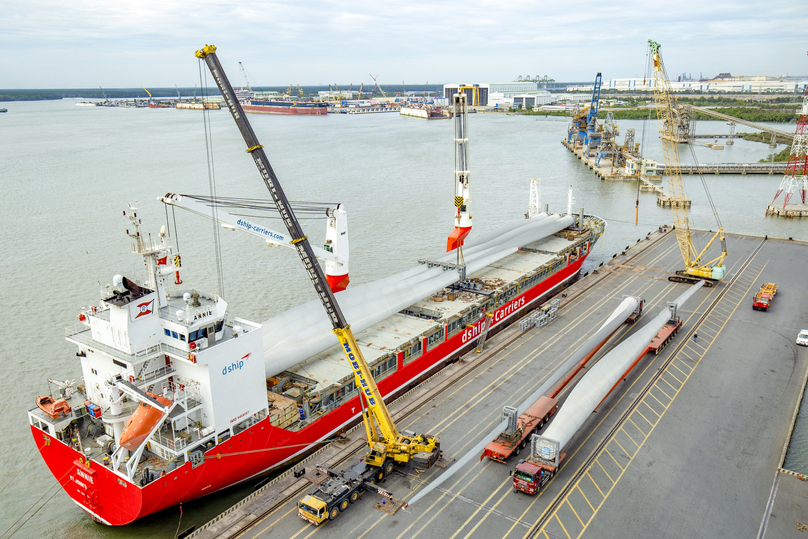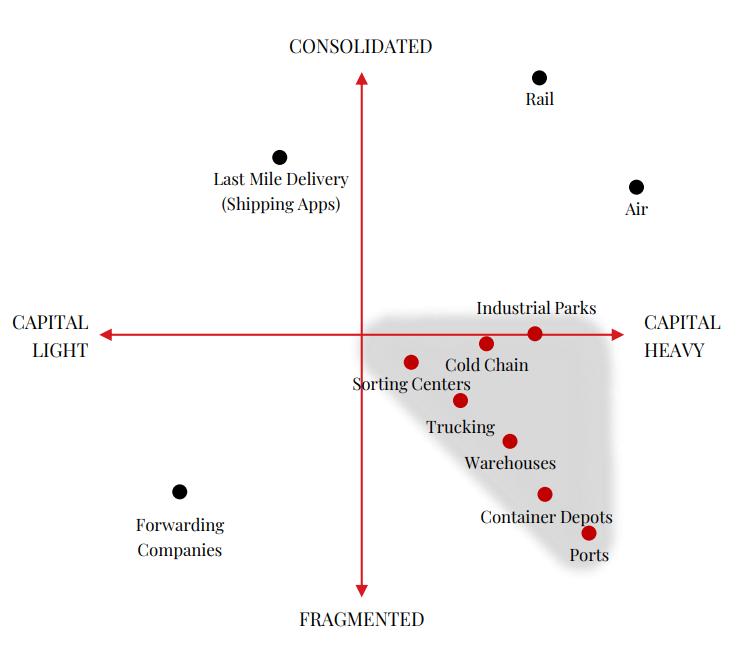Vietnam's booming logistics sector still has room for growth
VinaCapital’s chief economist Michael Kokalari explains why investors should pay close attention to various opportunities in Vietnam’s logistics industry.

Vietnam has one of the fastest-growing logistics sectors in the world, but the sector is still highly fragmented, which presents attractive investment opportunities for private equity firms and other well-capitalized investors with “on the ground” expertise helping local businesses accelerate their revenues and earnings by adopting international best practices.
The industry has grown 14-16% annually in recent years, according to the Vietnam Logistics Business Association (VLBA), and total logistics expenditures in Vietnam are equivalent to over 20% of GDP, which is among the highest in the world - because of the industry’s innumerable inefficiencies. For example, three-quarters of Vietnam's freight volume passes through just six of the country's 75 seaports.
The rapid growth of Vietnam’s logistics sector growth is sustainable because of: 1) the ongoing expansion of the country’s manufacturing sector – driven by the manufacturing of high-tech products, and 2) the continued growth of the country’s middle class.
Regarding the former, Vietnam’s manufacturing sector currently accounts for just over 20% of the country’s economy but this figure reached above 30% for other “Asian Tiger” economies. That continued FDI investment inflows – which have helped fund the build-out of Vietnam’s industrial base for – are essentially ensured for years to come, partly because Vietnam is a beneficiary of the nascent “friend-shoring” phenomenon, which we discussed in this report, and which is part-and-parcel of the broader “China + 1” effort of multinational companies to diversify some of their production outside of China (ie. to Vietnam, India, Mexico, etc.)
Finally, the ongoing growth of Vietnam’s middle class also presents numerous investment opportunities, especially in niches such as cold-chain logistics - because of greater demand for fresh food and certain perishable pharmaceutical products - and in e-commerce beneficiaries such as last-mile delivery services. Further to that last point, e-commerce in Vietnam is growing by more than 25% annually, and the Vietnamese government targets a much bigger role for e-commerce for the country’s economy going forward – which is likely to lead to a regulatory environment that is especially favorable for “last mile” and other logistics firms.

A port in the Cai Mep-Thi Vai port cluster in Ba Ria-Vung Tau province, southern Vietnam. Photo courtesy of Ba Ria-Vung Tau newspaper.
Overview of Vietnam’s logistics industry
Vietnam’s logistics industry is comprised of foreign and local firms, but local firms are essentially absent from the international shipping business (there are over 1,600 registered ships in Vietnam - but only 3% of those ships are proper container ships) - with the exception of the handling and delivery of goods overland across Vietnam’s northern border with China (although this conduit represents a small portion of the goods that flow in and out of Vietnam). The industry’s biggest challenge is increasing the quality and reliability of its services – but these problems can be addressed by replicating best practices from other logistics markets.

In order to analyze the investment opportunities in the sector, we’ve partitioned the industry into capital-intensive versus “capital-light” businesses, and into segments of the industry that are highly fragmented, versus those that are highly concentrated, as can be seen above, and we note that the domestic logistics industry is comprised mostly of micro-to-small companies.
The businesses in Vietnam’s logistics sector most in need of investment are those that are capital intensive, and in segments of the industry that are highly fragmented. For example, transportation firms account for about two-thirds of the total enterprises in Vietnam’s logistics industry, but over 80% of trucking firms in Vietnam have a fleet size of fewer than five trucks, and it’s estimated that for about 70% of the deliveries trucks in Vietnam make, the trucks returns to their home base empty.
Furthermore, middlemen get paid an estimated 30% commission on the final service fees that those trucking companies earn. Even in cold storage transport, which is considered to be one of the most promising segments of Vietnam’s logistics industry, and which is dominated by foreign-invested firms, is estimated that 70% of firms have less than 10 trucks.
In our view, some very compelling opportunities for local firms stem from the fact that sophisticated foreign customers are willing to pay premium prices for reliable logistics services, and that middle-class customers’ demand for products and services that entail high-quality logistics is soaring (ie. online shopping with home delivery, demand for perishable foods & medicines, etc).
Additionally, the long-term investment returns generated from those companies will be augmented by the fact that Vietnamese logistics operators that have sufficient scale and are professionally managed will experience falling costs over time, as bottlenecks stemming from Vietnam’s infrastructure and other issues are eventually addressed.
We also expect attractive investment returns for logistics firms that are beneficiaries of increased high-tech manufacturing in Vietnam and from the ongoing growth of Vietnam’s emerging middle class.
The growth of high-tech manufacturing entails increased demand for higher value-added logistics services such as bonded warehouses for the consolidation of relatively high-value goods (compared to garments & footwear, for example), before those products are exported. Also, the input materials for the production of consumer electronics are typically very valuable, so customs clearance and freight forwarding activities entailed in handling those items necessarily must be of much higher precision and specification than that entailed in handling textiles and yarn for garment production, for example.
Finally, we see three potential investment strategies: 1) invest in leading logistics companies, to aggressively grow their assets into an integrated platform that offers clients economies of scale, 2) identify particular assets which need capital for upgrading or can be re-purposed, and drive new business by increasing efficiencies, and 3) M&A / consolidation. The adoption of best international practices – such as digitization – together with capital injections are critical to all of these strategies, although capital injections are particularly essential if the investors’ strategy is to grow the capacity of the target firm – by adding more trucks, for example, or additional cranes/heavy equipment in port/warehouse businesses.
Attractive segments
One attractive niche in Vietnam’s logistics industry is the customs clearance business, in which brokers with good relationships with the proper officials can expedite the clearance of goods in and out of the country by assuring compliance with complex regulations.
Most of Vietnam’s 800+ freight forwarding companies provide customs clearance services, according to the VLBA, but we believe firms that can bundle customs clearance services as part of a “core carrier” relationship, are capable of satisfying all of the shipping/logistics needs of high tech manufacturing firms can enjoy enhanced pricing power in exchange for providing premium logistics services to those firms.
Further to that last point, high-quality logistics are essential to the handling of high-value consumer electronics items, but logistics costs account for just over 1% of the final price of those items (versus circa 30% for agriculture products like rice, for example). The combination of customers’ high sensitivity to quality, together with the low contribution of logistics services to the total costs of consumer electronics producers equates to enhanced pricing power for integrated logistics firms that are able to service the needs of those demanding customers, by providing what is known in the industry as “Third Party Logistics Services (3PL)”
The vast majority of logistics handling done by local firms in Vietnam can be characterized as “First Party Logistics (1PL)”, or “Second Party Logistics (2PL)”, which essentially facilitates the direct shipment of products from one point to another, but the global logistics industry is increasingly moving towards the so-called “3PL” model in which Logistics Service Providers (LSP), provide not only transportation & warehousing services, but additional value-added services such as inventory management, picking & packing, and RFID tracking.
The larger firms in Vietnam’s logistics industry are primarily state-owned enterprises (SOEs), so although those firms may have the financial resources to begin providing 3PL services, they typically do not have the flexibility and/or management capability.
Summary
Vietnam has one of the fastest-growing logistics sectors in the world, and that growth is expected to continue for years to come, driven by the continued expansion of the country’s manufacturing sector (especially high-tech manufacturing), and by the continued growth of the country’s middle-class, which in turn is driving high growth in the logistics-intensive e-commerce business, as well as demand for perishable food and other products.
The industry is fragmented and inefficient, which when combined with its high growth is a recipe for attractive investment returns. In our view, the most attractive businesses to invest in are those that are capital-intensive and are in particularly fragmented segments of the industry.
- Read More
TCBS overtakes SSI to become Vietnam’s largest securities company by market cap
Over 2.3 billion shares of Techcom Securities JSC (TCBS) debuted on the Ho Chi Minh City Stock Exchange (HoSE) on Tuesday. The stock, TCX, recorded the highest price and the largest market capitalization in the Vietnamese securities sector.
Finance - Tue, October 21, 2025 | 10:27 pm GMT+7
Indonesia’s palm oil industry becomes investment magnet
Indonesia’s palm oil sector attracted IDR52.7 trillion, or approximately $3.2 billion, in investment during the first nine months of this year, with the money going into enabling the country to capture more value out of its top commodity, the country’s Ministry of Investment reported.
Southeast Asia - Tue, October 21, 2025 | 9:34 pm GMT+7
Indonesia reports strong job, investment growth
The Indonesian Coordinating Ministry for Economic Affairs reported strong job and investment growth during the first year of President Prabowo Subianto’s administration, compared with the first year under his predecessor.
Southeast Asia - Tue, October 21, 2025 | 9:29 pm GMT+7
Singapore grants conditional approval for 1GW low-carbon power import from Malaysia
Singapore has granted conditional approval to import 1 GW of low-carbon electricity from the Malaysian state of Sarawak, marking a new phase in the energy partnership between the two countries.
Southeast Asia - Tue, October 21, 2025 | 9:26 pm GMT+7
Margin lending in Vietnam’s stock market hits record, but not worrisome
Despite margin debt in Vietnam’s stock market surging sharply, experts believe that current margin pressure is not yet a major concern as top securities firms have significantly strengthened their capital buffers.
Finance - Tue, October 21, 2025 | 4:23 pm GMT+7
Lenders in Vietnam now in low-rate lending race: ACB exec
The biggest “headache” for banks in Vietnam now is that profit margins are getting thinner, said CEO of Asia Commercial Bank (ACB) Tu Tien Phat.
Banking & Finance - Tue, October 21, 2025 | 4:00 pm GMT+7
PV Gas - 35 years of innovation and technological leadership in Vietnam’s gas industry
Over the past 35 years of establishment and development (1990-2025), PV Gas, a subsidiary of state-owned giant Petrovietnam, has affirmed its pioneering position in Vietnam’s gas industry, marked by a series of groundbreaking achievements in science and technology.
Companies - Tue, October 21, 2025 | 3:45 pm GMT+7
Vietnam's consumer finance major F88 achieves 90% of year's profit target after 9 months
F88 Investment JSC (F88), a leading consumer finance company in Vietnam, reported a cumulative pre-tax profit of VND603 billion ($22.88 million) in the first nine months of 2025, a 2.5-fold increase year-on-year, reaching 90% of its full-year target of VND673 billion.
Companies - Tue, October 21, 2025 | 3:15 pm GMT+7
Vietnam corporate earnings to be driven by credit expansion, trading activity, property recovery
With Q3 earnings season underway, results are expected to come in broadly in line with expectations. Financials should remain the largest contributors, benefiting from credit expansion and trading activity, while real estate continues to recover as project launches and sales rates improve, writes Tung Dang, associate director at Dragon Capital.
Economy - Tue, October 21, 2025 | 2:33 pm GMT+7
Inland port opens in southern Vietnam province Tay Ninh, set to become border logistics hub
The 16.5-hectare Tan Cang-Moc Bai inland port in Tay Ninh province, southern Vietnam has been opened, offering logistics services and handling customs clearance for imports and exports.
Infrastructure - Tue, October 21, 2025 | 12:03 pm GMT+7
State-managed property trading centers will help curb speculation, price manipulation: expert
Establishment of state-managed real estate trading centers is expected to create a transparent transaction channel, helping control and limit speculation and price manipulation in the Vietnamese market.
Real Estate - Tue, October 21, 2025 | 8:37 am GMT+7
Vietnam's benchmark VN-Index records sharpest drop in 25-year history
VN-Index, which represents the Ho Chi Minh Stock Exchange (HoSE), saw the sharpest decline in its 25-year history on Monday, down by 94.76 points, or 5.47%, to 1,636.43.
Finance - Mon, October 20, 2025 | 5:49 pm GMT+7
Construction contractor Coteccons sets record FY2026 targets, capital base hike via share issue
Coteccons Construction JSC (HoSE: CTD), one of Vietnam’s largest construction contractors, has set ambitious targets for its fiscal year 2026, driven by a record order backlog and its push into international markets.
Companies - Mon, October 20, 2025 | 4:50 pm GMT+7
Real estate, gold markets to be fully established by 2026: Prime Minister
Vietnam plans to complete comprehensive legal framework for its financial, real estate, and gold markets by 2026 as part of a broader effort to modernize market infrastructure and accelerate economic growth, said Prime Minister Pham Minh Chinh.
Finance - Mon, October 20, 2025 | 3:33 pm GMT+7
Vietnam breaks ground on nation’s most advanced domed stadium in Hung Yen province
Vietnam’s Ministry of Public Security has broken ground on a 60,000-seat domed stadium in the northern province of Hung Yen, set to become the country’s most technologically advanced sports venue.
Society - Mon, October 20, 2025 | 2:48 pm GMT+7
Workforce and logistics - keys to sustainable e-commerce growth in Vietnam: experts
Businesses and online shop owners in Vietnam should pay greater attention to human resources and logistics, considering these factors “keys” to competitive advantage in the increasingly volatile e-commerce market, according to experts.
Economy - Mon, October 20, 2025 | 10:54 am GMT+7
- Travel
-
Sun Group gets nod for $375 mln inland waterway tourism project in central Vietnam
-
Hilton signs strategic partnership with Sun Group to develop 5 hotels in Vietnam
-
Long Thanh airport to handle 80% of int’l flights to HCMC area, Tan Son Nhat airport 20%
-
New train helps tourists explore landmarks of Hanoi, Bac Ninh province
-
Cam Ranh airport in central Vietnam tourism hub set to be among country’s largest
-
VAFIE hosts second 'Golf Club for Business' outing
























